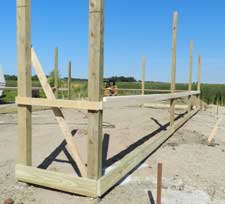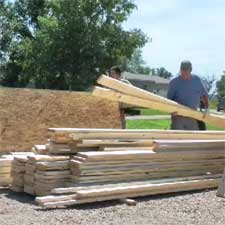The Big Stick is Better than the Little Stick – Right?
Those of you who are regular readers know I am fascinated by all things magical. I don’t know how they do it, but I will watch a good magician over and over.
When I was in architecture school at the University of Idaho – the Amazing Randi (https://en.wikipedia.org/wiki/James_Randi) did a performance there. Asking for a volunteer to give up a piece of their clothing – I handed over my favorite denim sports coat, which he proceeded to cut in half on stage (to my horror). It was returned to me intact and unharmed after the show! To this day I have absolutely no idea how he did it.
Well – lumber doesn’t come along with magic, but it can do some magical things. One of those is allowing a lesser sized piece of lumber (of an equal grade) to do things a bigger piece can’t do!
Let’s take a look at a 4×6 and a 6×6 of #2 Hem-Fir, both of which are commonly used in pole buildings for columns. For sake of simplicity, we will just examine the lumber bending properties – as the ability to resist wind loads is the primary function of a column.
As either piece, when incised, has the strength in lumber bending value decreased by 20%, I will leave it out of the discussion as well.
The 4×6 – has a base Fb (fiberstress in bending) value of 850 psi. Lumber which has a least dimension of four inches or less has a width adjustment factor (Cf) of 1.3, making the size adjusted value 1105 psi. As the size adjusted bending value is not over 1150 psi, no adjustment for wet use is needed. When used with the wide face towards the wind a flatwise use factor (Cfu) is applied of 1.05 for a Fb of 1160.25.
Used with four inches to the wind the Section Modulus (Sm) of the 4×6 is 17.65 inches, as a 6×4 11.23. Multiplying the Sm values by Fb, gives a moment resisting value of 19,503.25 in-lb for the 4×6 and 13,029.6 for the 6×4.
Now on to the bigger piece. The 6×6 has a Fb value of 575 psi. Posts and timbers (smallest dimension five inches or larger) do not get a size adjustment. The Sm of the 6×6 is 27.73. Multiplying by Fb gives a value of 15,944.3.
Looking strictly at lumber bending the 4×6 is 22.3% stronger than the 6×6, while the 6×6 is 22.4% stronger than the 6×4.
In many cases, as if by magic, the smaller piece of lumber will outperform the larger piece! Plus the side bonuses – the smaller piece of lumber has smaller (and fewer) allowable defects (https://www.hansenpolebuildings.com/blog/2013/12/lumber-defects/) and it will be about 1/3 lighter in weight!
Even the Amazing Randi can’t debunk this one!
For more reading on lumber bending: https://www.hansenpolebuildings.com/blog/2012/09/bending-moment/










In your post, lumber bending stresses, you discuss the dimensions of posts as 4×6 and 6×4. I assume you are inferring that the 4×6 is narrow side facing the side wall. Does it matter how the building is positioned concerning prevaling wind?
The Fb values differ depending upon if it is positioned 3-1/2″ face to the wind (larger Sm, lower Fb) or 5-1/2″ (we then reference it as 6×4 for clarity). In structural design, we have to assume the prevailing (or greatest) wind load will be taken by any wall, so orientation on site to prevailing wind is irrelevant.
You explain Fb (fiberstress in bending) . But then you don’t explain (Sm), (Cf), or (Cfu) and lose the audience, or at least me.
You are absolutely correct, please visit upcoming articles where these terms will be further explained.